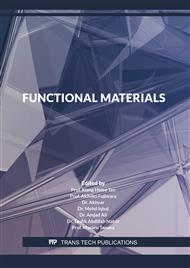[1]
Lembke, D.; Bertolazzi, S. and Kis, A., Single-layer MoS2 electronics, Acc. Chem. Res., 48 (2015), 100-110.
DOI: 10.1021/ar500274q
Google Scholar
[2]
Du, J.-y.; Ge, C.; Riahi, H.; Guo, E.-j.; He, M.; Wang, C.; Yang, G.-z. and Jin, K.-j., Dual-gated MoS2 transistors for synaptic and programmable logic functions, Adv. Electron. Mater., 6 (2020), 1901408.
DOI: 10.1002/aelm.201901408
Google Scholar
[3]
Liu, C.; Zou, X.; Wu, M.-C.; Wang, Y.; Lv, Y.; Duan, X.; Zhang, S.; Liu, X.; Wu, W.-W.; Hu, W.; Fan, Z. and Liao, L., Polarization-resolved broadband MoS2/black phosphorus/MoS2 optoelectronic memory with ultralong retention time and ultrahigh switching ratio, Adv. Funct. Mater., 31 (2021), 2100781.
DOI: 10.1002/adfm.202100781
Google Scholar
[4]
Wang, X.; Zheng, B.; Yi, J.; Liu, H.; Sun, X.; Zhu, C.; Liu, Y.; Fang, L.; Li, D. and Pan, A., Controlled growth of SnSe/MoS2 vertical p-n heterojunction for optoelectronic applications, Nano Futures, 5 (2021), 015002.
DOI: 10.1088/2399-1984/abd53a
Google Scholar
[5]
Wan, Y.; Xiao, J.; Li, J.; Fang, X.; Zhang, K.; Fu, L.; Li, P.; Song, Z.; Zhang, H.; Wang, Y.; Zhao, M.; Lu, J.; Tang, N.; Ran, G.; Zhang, X.; Ye, Y. and Dai, L., Epitaxial single-layer MoS2 on GaN with enhanced valley helicity, Adv. Mater., 30 (2018), 1703888.
DOI: 10.1002/adma.201703888
Google Scholar
[6]
Wan, Y.; Cheng, X.; Li, Y.; Wang, Y.; Du, Y.; Zhao, Y.; Peng, B.; Dai, L. and Kan, E., Manipulating the Raman scattering rotation via magnetic field in an MoS2 monolayer, RSC Adv., 11 (2021), 4035-4041.
DOI: 10.1039/d0ra09350e
Google Scholar
[7]
Liu, T. and Liu, Z., 2D MoS2 nanostructures for biomedical applications, Adv. Healthcare Mater., 7 (2018), 1701158.
Google Scholar
[8]
Liu, M.; Zhu, H.; Wang, Y.; Sevencan, C. and Li, B. L., Functionalized MoS2-based nanomaterials for cancer phototherapy and other biomedical applications, ACS Mater. Lett., 3 (2021), 462-496.
DOI: 10.1021/acsmaterialslett.1c00073
Google Scholar
[9]
Wan, Y.; Zhang, Z.; Xu, X.; Zhang, Z.; Li, P.; Fang, X.; Zhang, K.; Yuan, K.; Liu, K.; Ran, G.; Li, Y.; Ye, Y. and Dai, L., Engineering active edge sites of fractal-shaped single-layer MoS2 catalysts for high-efficiency hydrogen evolution, Nano Energy, 51 (2018), 786-792.
DOI: 10.1016/j.nanoen.2018.02.027
Google Scholar
[10]
Chu, K.; Liu, Y.-p.; Li, Y.-b.; Guo, Y.-l. and Tian, Y., Two-dimensional (2D)/2D interface engineering of a MoS2/C3N4 heterostructure for promoted electrocatalytic nitrogen fixation, ACS Appl. Mater. Interfaces, 12 (2020), 7081-7090.
DOI: 10.1021/acsami.9b18263
Google Scholar
[11]
Pierson, H. O., Handbook of chemical vapor deposition: principles, technology and applications, William Andrew, New York, (1999).
Google Scholar
[12]
Park, J.-H. and Sudarshan, T., Chemical vapor deposition, USA ASM international, Russell Township, (2001).
Google Scholar
[13]
Shi, Y.; Li, H. and Li, L.-J., Recent advances in controlled synthesis of two-dimensional transition metal dichalcogenides via vapour deposition techniques, Chem. Soc. Rev., 44 (2015), 2744-2756.
DOI: 10.1039/c4cs00256c
Google Scholar
[14]
Choudhary, N.; Park, J.; Hwang, J. Y. and Choi, W., Growth of large-scale and thickness-modulated MoS2 nanosheets, ACS Appl. Mater. Interfaces, 6 (2014), 21215-21222.
DOI: 10.1021/am506198b
Google Scholar
[15]
Xu, X.; Das, G.; He, X.; Hedhili, M. N.; Fabrizio, E. D.; Zhang, X. and Alshareef, H. N., High-performance monolayer MoS2 films at the wafer scale by two-step growth, Adv. Funct. Mater., 29 (2019), 1901070.
DOI: 10.1002/adfm.201901070
Google Scholar
[16]
Ling, X.; Lee, Y.-H.; Lin, Y.; Fang, W.; Yu, L.; Dresselhaus, M. S. and Kong, J., Role of the seeding promoter in MoS2 growth by chemical vapor deposition, Nano Lett., 14 (2014), 464-472.
DOI: 10.1021/nl4033704
Google Scholar
[17]
Wan, Y.; Zhang, H.; Wang, W.; Sheng, B.; Zhang, K.; Wang, Y.; Song, Q.; Mao, N.; Li, Y.; Wang, X.; Zhang, J. and Dai, L., Origin of improved optical quality of monolayer molybdenum disulfide grown on hexagonal boron nitride substrate, Small, 12 (2016), 198-203.
DOI: 10.1002/smll.201502141
Google Scholar
[18]
Lee, J.; Pak, S.; Giraud, P.; Lee, Y. W.; Cho, Y.; Hong, J.; Jang, A. R.; Chung, H. S.; Hong, W. K. and Jeong, H. Y., Thermodynamically stable synthesis of large-scale and highly crystalline transition metal dichalcogenide monolayers and their unipolar n-n heterojunction devices, Adv. Mater., 29 (2017), 1702206.
DOI: 10.1002/adma.201702206
Google Scholar
[19]
Mak, K. F.; Lee, C.; Hone, J.; Shan, J. and Heinz, T. F., Atomically thin MoS2: a new direct-gap semiconductor, Phys. Rev. Lett., 105 (2010), 136805.
DOI: 10.1103/physrevlett.105.136805
Google Scholar
[20]
Splendiani, A.; Sun, L.; Zhang, Y.; Li, T.; Kim, J.; Chim, C.-Y.; Galli, G. and Wang, F., Emerging photoluminescence in monolayer MoS2, Nano Lett., 10 (2010), 1271-1275.
DOI: 10.1021/nl903868w
Google Scholar
[21]
Eda, G.; Yamaguchi, H.; Voiry, D.; Fujita, T.; Chen, M. and Chhowalla, M., Photoluminescence from chemically exfoliated MoS2, Nano Lett., 11 (2011), 5111-5116.
DOI: 10.1021/nl201874w
Google Scholar



